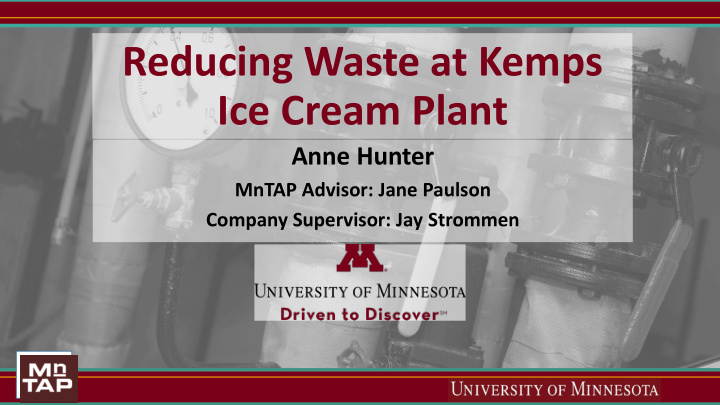



Reducing Waste at Kemps Ice Cream Plant Anne Hunter MnTAP Advisor: Jane Paulson Company Supervisor: Jay Strommen
Company Background • Name: Kemps Ice Cream • Location: Rochester, MN • 200 employees • 700,000 gallons of ice cream per week
Reasons for MnTAP Assistance • High biochemical oxygen demand (BOD) levels in wastewater • Daily reports show losses • Gather information about ingredient loss in established processes • Gain a better understanding of where waste occurs in the process
Overview Goal: To make process change recommendations that will reduce liquid ingredient and product loss High temp.- short time pasteurizer Raw Blend Trucks tanks Tanks Vat pasteurizers Freezers/ Flavor Pasteurized Packaging Vats tanks
Approach • Collected data using tank inventory differences • Collected rinse samples from dairy trucks • Observed cleaning processes on post-pasteurization side of plant • Collected samples of Clean In Place (CIP) pre-rinses for many types of processes
Tank Calibration Recommendation: Calibrate tank gauges • Loss reports will be more accurate • Resources can be spent more efficiently • Can double-check amounts • Variance = Raw tank weight difference brought in by truck - Scale Ticket Weight • Correction needed for dairy ingredients for water used to rinse trucks
Dairy Truck Intake • Water used to rinse dairy trucks may still be cloudy after diverted to drain • Negligible product loss occurs EXCEPT when: • Cream comes from more than 2 hours away • Whey settles in truck and clogs filter Recommendation: • Standardize unloading procedures • Continue minimizing high loss situations
Sugar Truck Intake • Liquid sugars are brought in by a pump provided by individual trucks • Connecting hose is full of sugar when pumping is complete and goes to waste • System is more prone to leakage Recommendation: Add existing sugar pump to the truck bay Savings: 10 gallons per load, 112,000 lbs or $23,000 of sugar per year
Compressed Air System • Compressed air system has several drains to prevent buildup of water • Two float drains • Two timed drains • Five open drains • One manually opened drain • When drains are open long enough to leak air, electricity is being wasted Recommendation: Replace timed, open, and manually opened air compressor drains with zero-loss air drains Savings: 256,000 kWh, or $24,300 in electricity costs
Recommendations Recommendation Product Energy Savings Adjust Annual Implementation Payback Status Savings Savings* Costs Period Sugar pump 112,000 lbs N/A $22,620 $54,260 2.4 years Recommended of sugar Air compressor N/A 256,000 kWh $24,300 $1,000** 0.5 months Recommended drains Total 112,000 lbs 256,000 kWh $46,920 $55,260** 1.2 years Recommended *Adjusted Annual Savings includes annual operating costs for a new sugar pump ** Estimated cost
CIP Pre-Rinse Data • Product lines show biggest potential for savings • Yogurt receiving lines and raw blend lines could be water-flushed better • Stations have more mix loss on the cleaning floor • More testing needs to be done in order to draw conclusions
Future Opportunities • Install a PIG system to clean 120 ft. of piping between pasteurized tanks and the flavor vats • Potential Savings: 16,500 gallons of mix will go to finished product instead of rework per year
Personal Benefits • First time in a manufacturing plant setting • Created and conducted experiments independently • Had to be flexible, patient, and creative in problem solving • Met new people with different backgrounds
Thank you for your time!
Recommend
More recommend